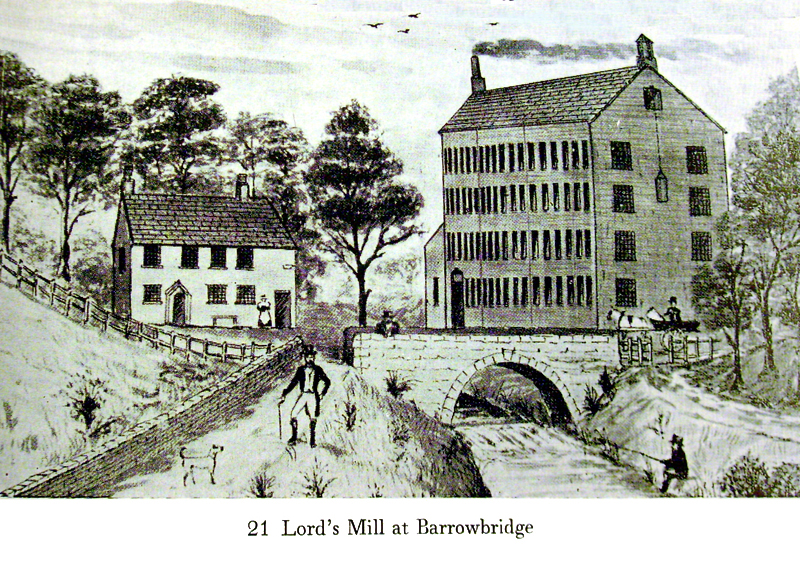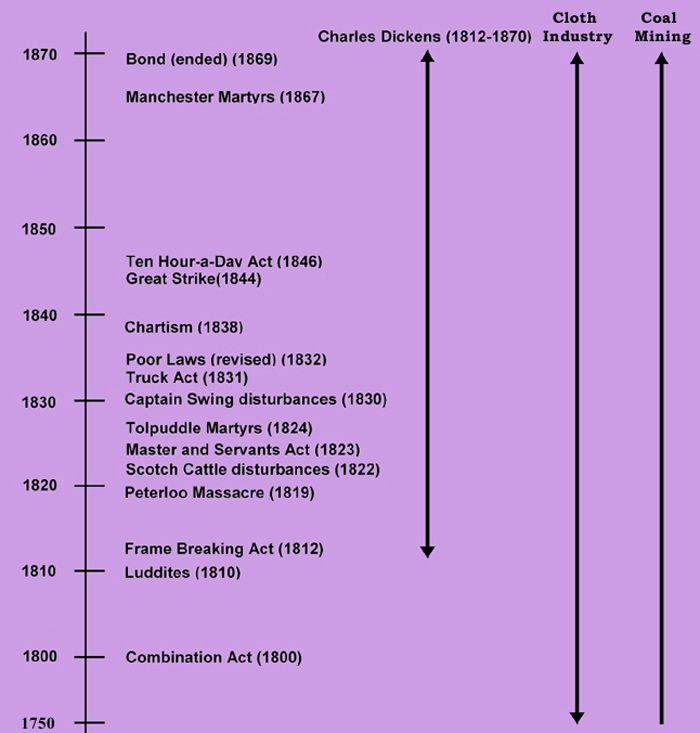

Cloth was originally made by hand, using the spinning wheel.
However, by attaching many spinning wheels to a common axle,
the output of yarn could be increased several times over.
Using a water wheel (or even a wind-mill, if the wind is
sufficiently constant), the axle of the water wheel could
drive the multiple spinning wheels. A water wheel axle could
also be set to turn another axle connected by gears but at a
right angle to the main axel of the water wheel. Using a
steam engine fueled by coal, was a more powerful source of
energy that could be used to produce yarn. The energy derived
from a steam engine was not subject to weather, drought, etc.
Using fibers from the cotton plant, wool, flax, silk, etc.,
different kinds of cloth could be manufactured. Once the fibers
had been produced, power machinery was then used to weave
cloth, as well as lace.
As new machinery was invented for the cloth industry, the
process of producing cloth increased in efficiency, therefore
fewer workers were required. However, while such low-cost
workers provide a labour supply, these workers cost money.
Housing was required. Health costs rose, as producing coal in
mines as well as working with machinery in the cloth industry
was dangerous. The initial cloth manufacturing machines had
unprotected "belts" (cheaper not to cover the belts) and the
fingers, hands, arms, feet and legs of workers (and sometimes
the entire body) were caught in these machines, thus maiming
or killing the workers. Cloth fibers caused lung diseases,
just as coal-dust also caused debilitating lung diseases.
Industrialists wanted to drive down costs, but workers could
not live on slave wages (and they often starved to death, in
spite of the penal
workhouses and
those "transported" for
stealing food). Social instability could be predicted, and
social instability is exactly what happened. Governments do
not handle instability well, a problem that governing bodies
did not know how to solve (except by using violent repression
to maintain the hierarchical "class" structure). As a rough
indication of these times, consider the following incomplete
"time line". What is shown is how instable the government
was: it was not able to deal with the forces it had unleashed
in this new society based upon a Capitalist Industrial
Revolution. The Industrial Revolution had been born!
Also note how so many of these important
events took place during the life time of Charles Dickens!

The Chartists and Socialists established their own reading
rooms, which they filled with politically-oriented journals
and included writers such as Helvétius, Holbach,
Diderot, Shelley, Byron, Bentham, Godwin, etc. The
capitalists responded by creating
"mechanics institutes"
with reading material strictly limited to technical subject
matter associated with work. One of the most important men
in struggling for the rights of workers was
W. P. Roberts, a solicitor.
He was a major figure in the Great Strike of 1844 (see Coal
Mining).
Yarn is quite interesting. It could be sold outside Great
Britain to secure profit, but how might yarn be used within
Great Britain? The "other half" of the cloth industry is the
weaving industry. Development of the domestic weaving
industry to support the export of cloth and take over the
great Colonial cloth industries such as in India, France,
China, etc. (to seek external markets) must yet be discussed.
The household spinning wheel had been used for many years.
The spinning wheel was used for cotton, flax, wool, and
silk. The spinning wheel had a spindle that was horizontal
to collect yarn. The way that the spindle was constructed
resulted in yarn collecting in a pyramidal shape or a
elliptical shape. One variant of the spinning wheel was
called the Saxony or Liepzig wheel, used for flax, but
the Saxony wheel used a more advanced kind of spindle with
a "flyer"
that collected yarn evenly and with the same tension on a
"bobbin". In 1769, Richard
Arkwright designed and constructed the first roller-spinner,
powered by a horse, an example of a "trapiche",
commonly used in the New World on slave plantations to
process sugarcane. Cloth "power spinners"
mills usually use a power source limited to either water-mills
or steam-engines. Almost simultaneously (1770), Hargreaves
designed the spinning "jenny".
This was an advance in that eight spinning wheels were
mounted on a single, common, axle, with vertical spindles.
Unfortunately, the jenny often broke yarn. In 1771,
Arkwright in conjunction with Mead and Strutt replaced
the horse trapiche by a water-wheel. Crompton designed
the "spinning-mule" which is
an advance on the jenny as aside from having the equivalent
of sixteen spinning wheels (it has 16 spindles), it doesn't
break yarn as the jenny does, and it is powered by a
water-mill! In 1775, Arkwright builds a mill on the Durwent
with vertical flyer-and-bobbin spindles. In 1775, the first
true yarn mill using power spinners, called the Cromford water
frame was created. In 1779, at Stockport, the
"slubbling billy"
was created. It uses wool, and combines the jenny with
the mule. Finally, in 1785, the steam engine was used as
a power source by Boulton and Watt at Nottinghamshire.
Hand "warping" machines allowed
warp filaments long enough to be collected into a heap and
more easily handled, all the filaments of the same length.
Click to see hand warping machine.
The warped yarn was then used on looms.
Headdles allowed the loom to
weave warp with woof fibers. Different shuttles could be
strung to different materials such as wool, flax, etc., or
yarns of different colors, producing "tweel".
A "batten" was used to push the
woof back towards where the cloth accumulates. The
"headdles" are composed of
hooks to which the warp filaments or yarn is attached. It
was then possible to attach foot-operated
"treadles" that selected a
headdle and raise the headdle, thereby catching or engaging
the warp yarns, and another foot treadle to pull down and
remove the warp yarns from the hooks on the headdle.
Thus the different headdles could then be selected to get
different patterns. Warp and woof could alternate different
fibers: wool, cotton, flax, and silk successively and in
different colors. This is called "draught"
and "cording". Mr. John Kay of
Bury [separate figure] improved the loom by inventing his
shuttle, which is selected by a "picking peg".
It was originally used for woolens in 1738, then cottons
in 1760. (Add Figure 97.) The design of a pattern for
selecting warp yarns by specific headdles was called
"drawing a warp". The plan of
the sequence of headdles was called a
"drought". Connecting the
headdles to treadles in the correct sequence was called
"cording". However, the warp
yarns tended to get tangled, filaments of yarn unraveled and
the warp yarns were not at equal tension. To remove this
problem, a paste, originally of a starchy flour (called a
"dressing" or
"sizing") was brushed on the
warp to smooth the filaments as well as stiffen them. A
comb was used to clear away knots and partially unraveled
yarn filaments. The humidity due to the dressing was removed
by a fanning action.
A water-powered "power-loom" was
invented circa 1785 by Dr. Edmund Cartwright, who then
successfully used steam power in 1792. In 1796 Robert Miller
of Glasgow, with John Montieth in 1801, started a power loom mill.
However, it was necessary to run the looms intermittently to allow
dressing of the warp. Such intermittent action prevented successful
use of such machines. This dressing problem was solved in 1803 and
1804 by Radcliffe and Ross, with the help of Thomas Johnson in
Stockport (Manchester). They solved the problem of dressing the
warp as follows:
The warp passes through a hot dressing of starch and is then
compressed between two rollers to extrude most of the moisture.
The warp is finally drawn over a succession of tin cylinders
heated by steam, which dries the dressed warp, aided by
revolving fanners. The power-loom was born! As a consequence,
the employment of hand-spinners and hand-weavers rapidly
declined, and the need for factory operatives was created.
The three major foundations of the Industrial Revolution
were the cloth (and related) industries; the coal and
iron mines (coal provided fuel for the steam engines and
iron was used to build the steam engines); and the slave
estates in the New World, Africa and India, which
provided capital that could be invested in machines and
mines as well as markets to sell cloth. The British
government engaged in a movement to abolish slavery which
was carefully targeted to the Atlantic slave trade, but by
no means opposed to slavery elsewhere! The purpose of this
Abolitionist movement was
to prevent capital formation in other countries such as
France and the Islamic-based countries trading in Africa,
to prevent these competitor countries from establishing
and elaborating their own Industrial Revolutions. However,
the Abolitionist movement had another very serious objective:
to replace New World slavery by
Colonialism. Why transport
slaves at high expense to the New World, when they could be
exploited exactly where they were located to begin with?
Indeed, "Buxton's government-sponsored expedition up the
Niger of 1841 was premised on the expectation that ... [would]...
"result in 'bringing forward into the world millions of consumers.@" Abolition of the Transatlantic
slave trade was far from independent of the "slavery"
practiced back in Britain. Slaves were bought partly by
barter using cloth in this process of barter, and plantation
slaves were "paid" in cloth as well. Thus the cloth
manufacturers in Manchester did not want slavery to end%.
The issues of Slavery and Colonialism will not be discussed any
further here. However, the theme of Slavery and Colonialism
did appear in novels by Charles Dickens ("Little Dorrit" and
"Bleak House" for example).
(See Footnote #1 on previous page.)
Much of this discussion is based upon "The Condition of the
Working Class in England", by Friedrich Engels.
© Copyright 2006 - 2018
The Esther M. Zimmer Lederberg Trust
 Web Site Terms of Use
Web Site Terms of Use